Architectural Icons of Thessaloniki: Eleven Stories Through Time
This short walk takes in eleven...
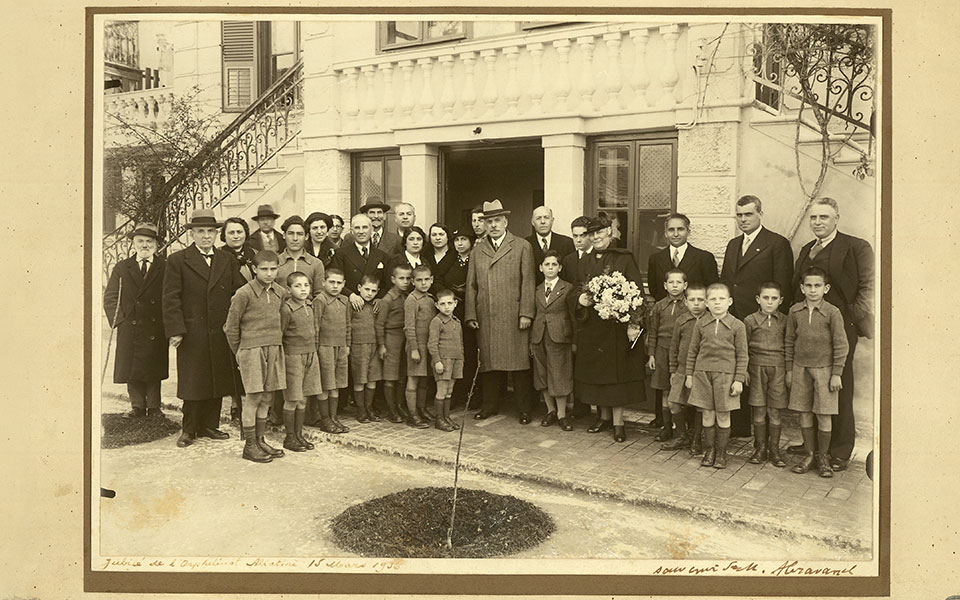
Patrons of the Allatini Jewish Orphanage pose with some of the children in March, 1936.
Let me take you for a walk down Thessaloniki’s epic road, the main boulevard of the district of Exoches, which still echoes with the voices of the Jewish community of Thessaloniki, a community which is gradually vanishing but whose members have left an indelible mark on the city.
No one can say for sure when the first Jews settled in Thessaloniki. They may have arrived from Alexandria, Egypt, around 140 BC. What is certain, though, is that during both the Roman era and the Byzantine period, the Jews of Thessaloniki had Greek names and had adopted the Greek language.
This ancient community, which came to be known as the “Romaniotes,” differentiated itself linguistically, culturally and socially for the first time in 1492, after the mass settlement of Sephardic Jews expelled from Spain. This was at a time when Thessaloniki, along with most of Greece, was under Ottoman rule.
The Sephardim introduced their own culture and customs, as well as their own language – a Judeo-Spanish tongue called “Ladino” that is still spoken today. Sultan Bayezid II welcomed them cordially, regarding them as an important addition to Thessaloniki’s workforce; many were, after all, experienced merchants and craftsmen.
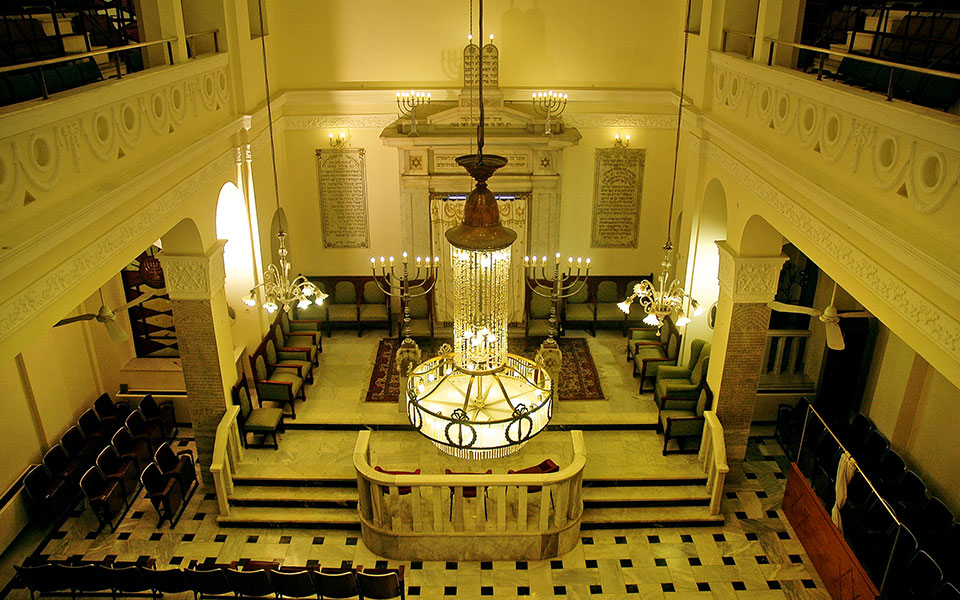
Founded in 1925, the Monastirioton Synagogue is the oldest in the city and the sole Jewish house of worship to survive the Nazi occupation.
© Aris Georgiou
During the 15th and 16th centuries, new waves of Jews expelled from Portugal, Italy, Sicily and France, together with refugees from North Africa, all settled in Thessaloniki and, by 1553, the city had become a leading Jewish center of Europe, with around 20,000 Jewish residents. With the passing of centuries, the Jewish population continued to increase. In 1891, thousands of new refugees, victims of the pogroms in Czarist Russia, further boosted the city’s Jewish numbers. By the second decade of the 20th century, Thessaloniki Jews constituted the largest population group in the city.
Prior to Thessaloniki’s liberation from Ottoman rule in 1912, the Jews lived in harmony alongside the Ottoman Turks, Orthodox Greeks and Slavs that made up the city’s other religious and ethnic groups. At the same time, they also fostered a community of their own within the city. A major factor in the financial and intellectual well-being of that community was the establishment in 1873 of the Alliance Israelite Universelle school, which offered a harmonious combination of religious and secular education.
The goal of the Alliance was, among other things, to contribute to the emancipation and the spiritual progress of all Jews around the world. This was something that they believed could only be achieved with a secular, Westernized form of education. Assimilation as a conscious, cultural choice represented a new and particularly enticing counter-proposal to their own established practices. Nonetheless, the Sephardim of the city did not cease to be deeply traditional and to conserve those cultural elements that had kept their community united throughout the centuries.
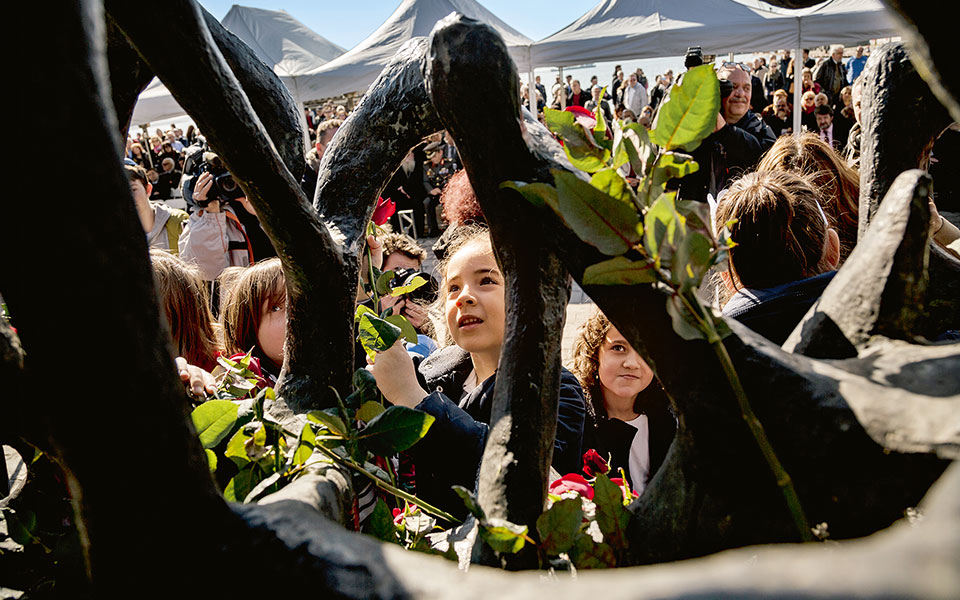
A ceremony at the Holocaust Memorial Menorah, a modern monument dedicated to the memory of the 50,000 Thessaloniki Jews killed in World War II death camps.
© Konstantinos Tsakalidis
After the Ottomans surrendered the city in 1912, things did not change dramatically for the Jewish community, despite some isolated anti-Semitic incidents that were contained after intervention by the Greek authorities. The Jews, however, had mixed feelings about the new state of things: they feared that the city’s liberation might hurt their civil and religious privileges, despite a declaration from King George of Greece that Jews (and all other minorities) were to have the same rights as the Orthodox Greek population.
Another event that marked the Jewish community of Thessaloniki was the Great Fire of 1917, which obliterated most of the town and left more than 50,000 Jews homeless. The fire destroyed the administrative offices of the community, the office of the Chief Rabbinate, various welfare institutions, thirty synagogues and 11 schools, including the Alliance Israelite Universelle. In the face of this catastrophe, the community nonetheless worked to provide schooling, healthcare and other services for its members. Despite these efforts, for many Jewish victims of the fire, the only solution was emigration.
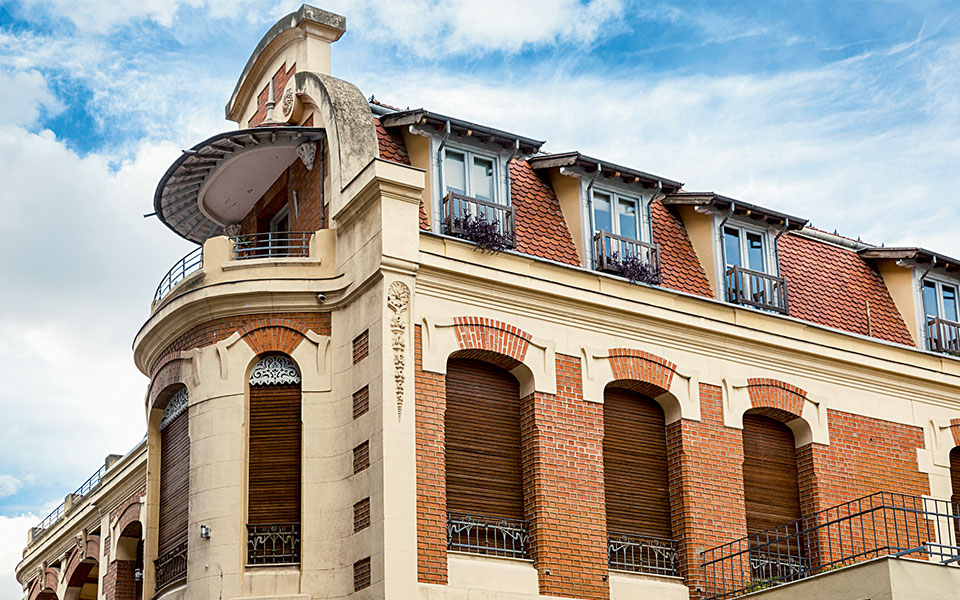
Villa Modiano is home to the Folklife and Ethnological Museum of Macedonia-Thrace. The neo-renaissance building was constructed in 1906.
© Konstantinos Tsakalidis
Most who left chose Paris, a decision easily explained if one considers the fact that quite a few Jews from Thessaloniki had received a French education, mostly thanks to the Alliance. The first wave of Thessaloniki Jews reached Paris in 1921; within the next six years, a total of 3,500 people had moved there. The arrival of Orthodox Greek refugees from Turkey in 1922 after the Asia Minor catastrophe and the subsequent reinforcement of the Christian character of the city forced even more Jews out of the city, and a new wave of Thessaloniki Jews decided to settle in Paris after 1927.
This group probably decided to do so after some encouraging articles in Jewish newspapers expressing the view that France ensured ideal working conditions. By the early ‘30s, however, France was struggling financially and many of the Greek Jews there were considering returning to Greece. More than 200 did eventually return, bringing with them the news of the not-so-favorable living conditions they’d left behind. At the same time, many Jews felt compelled to emigrate, especially after the Campbell Riot of 1931, during which ultra-right extremist elements burned to the ground the entire Campbell neighborhood, a largely Jewish district.
Of course, a number of Jews had left Thessaloniki for various reasons a long time before these events. Among them were the ancestors of the Dassault family (descendants of the Allatini family), who are today repeatedly referenced by the world media in connection with Air France, Dassault Aviation (a leading producer of aircraft both civil and military, spacecraft design and systems that include defense and ground telemetry capabilities) and, of course, the well-known French newspaper “Le Figaro,” which the family owns.
Jewish families like the Allatini, the Mordoch, the Modiano, the Fernandez and the Mallah – from which the former president of France Nicolas Sarkozy is descended – were instrumental in the history of the city and their names still grace streets, bus stops, villas, hospitals, factories and central arcades. It’s a blessing that some of the buildings, in particular the mansions and the headquarters of these families’ industries, remain today to remind us that, before their owners – distinguished industrialists, merchants and bankers – left the city for good, they lived here and flourished.
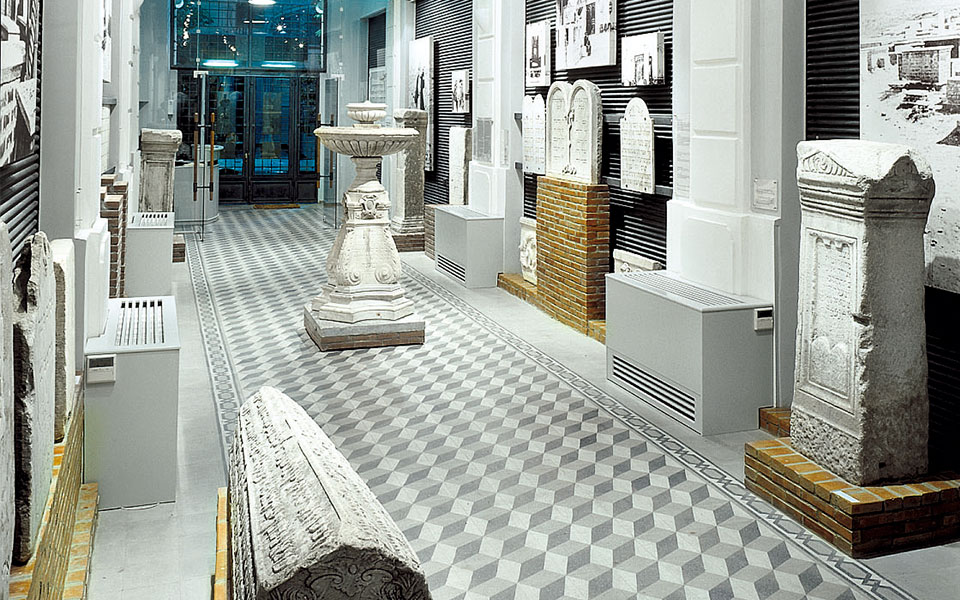
Tombstones and other stone objects from the Jewish cemetery that once lay to the east of the city walls.
The occupation of Greece by Axis forces marked the beginning of the end for the remaining Thessaloniki Jews. The Germans entered the city on April 9, 1941 and, a few days later, Jews were banned from cafés, pastry shops and other public spaces. The Germans occupied the Hirsch Hospital and many Jewish homes, imprisoned the members of the Community Council and looted the Community offices and the richest Jewish libraries.
In July of 1942, orders were issued for all adult male Jews between the ages of 18 to 45 to present themselves at Eleftherias (Liberty) Square. There, after being subjected to indescribable humiliations, they were registered and taken away for forced labor. From February of 1943, Thessaloniki’s Jews were forced to wear the yellow Star of David and to live only in designated neighborhoods, i.e., ghettos. In March of that year, the first rail convoy departed for the extermination camp of Auschwitz/Birkenau; other convoys followed. Only a small number managed to escape deportation and enter the resistance. These fighters would return to Thessaloniki after the city’s liberation in 1944 and, together with the few concentration camp survivors, would attempt to create a new life for themselves amid the ruins.
As those who witnessed the Holocaust and survived depart from us one by one, Thessaloniki needs to make sure that it keeps the glorious history of its Jewish community alive. Our biggest problem, however, is not that we are left with no first-hand witnesses of the greatest crime ever committed against mankind; it is that the voices of those who doubt that this crime was ever committed are growing louder. In the map at the top of this article, you will find important sites that bear compelling testimony, as long as people listen.
Thessaloniki-born Leon Nar is a versatile writer who also teaches Greek literature at Anatolia College. His books include Thessaloniki 1912-2012, The Future of the Past, with photos by Yorgis Yerolymbos (Kapon Editions).
This short walk takes in eleven...
Where dusk, movement, and memory meet,...
From major infrastructure projects to a...
A forgotten world comes to life...